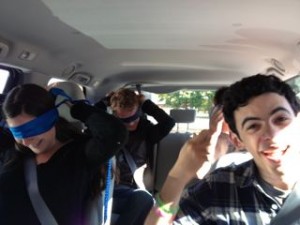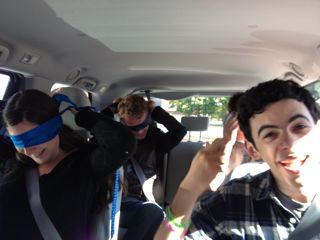Science Curriculum Changes to Physics First
On a blustery day in late fall, science teacher Paul Rutherford herded a class of physics students onto a school van. While Rutherford clambered behind the steering wheel, the students put blindfolds over their eyes.

The van started moving. Could the students tell how fast the bus was going? Rutherford asked. They could not. He turned a corner. Suddenly, his passengers could feel the movement, even if they couldn’t see it.
The students had just learned a lesson in the physics of motion, and had learned it in a way that kept them actively engaged.
Science Department Head Bill Berghoff relishes this type of hands-on learning. By next year, he hopes to see quite a bit more of it happening around campus.
“There’s going to be a lot of physics experiments, a lot of light and sound and dropping objects,” he said, adding with a grin, “There’s going to be lots of weird stuff going on, I think, next year.”
Berghoff, who was hired two years ago after working at Choate, has taught under several different science curricula. When he started working at The Williston Northampton School, one of the first things he did was sit in on other teachers’ science classes. What he saw, particularly among the ninth graders, was a struggle with the fundamentals.
“I’m sitting in a biology class and they spend the first four to six weeks doing chemistry, but the kids didn’t have any background really,” Beghoff said. “They brought a little from middle school, but it was in all different places.”
“So it was really difficult topic to start the ninth graders with, because it’s a little bit dry,” he said. “You’re talking about protons and electrons and molecules and charges. There’s not a lot going on for them.”
While biology students were struggling with chemistry basics, chemistry students were learning about energy, waves, and charges—the fundamentals of physics.
“Again, the kids didn’t have any idea what these things were,” Berghoff said. “So it seemed to me at that point… that we were doing things backwards. Is there a better way to do it than what we’re currently doing?”
The key goals—to develop skills and an experience that would carry students through years of science—didn’t seem to be happening under the existing sequence of classes. Instead, Berghoff and his colleagues started taking a look at a format that would introduce physics in the ninth grade.
Although many people equate physics with higher-end mathematics, it doesn’t have to be taught that way, Berghoff said. Ninth grade physics, also called “physics first” began appearing in schools in the 1990s, and has since become a popular method for introducing students to science, he said. For a ninth grade physics class, for example, lessons would be more about learning basic concepts than about understanding complicated equations.
“Can you explain to me why a feather and a rock hit the ground at the same time if you drop them off the roof?” Berghoff said. “ You can explain that without any numbers at all. The ratio between the force and the mass are the same, so they fall at the same rate.”
In the existing physics classes, much of this experimentation is already happening. A month after their blind-folded van ride, Rutherford’s students clustered in a third-floor bathroom in the Schoolhouse, to see if the structures they constructed to protect the eggs would allow them to fall without breaking.
Before they decided on a new curriculum, though, the Williston science teachers spent several months discussing the different sequences of classes, plus the logistics of a transition. When the question came to a vote, it was unanimous; the physics-first curriculum was the way they wanted to go.
Starting next year, ninth and returning 10th graders will start the fall with physics classes. (New 10th graders who have had physics in ninth grade at their previous school may opt to advance to chemistry.) Juniors and seniors, who will still be in the former sequence, will continue to take chemistry and the more advanced physics classes. Since fewer students will be enrolled in biology, most of those teachers will switch to physics for a year or two of transition, Berghoff said.
“There’s going to be this continuum I see of science,” he said. “We know where we want to go, and now we’re just going to develop curriculum to suit that, rather than be driven by something else.”
Science teacher Paul Luikart said that putting chemistry before biology would give Williston students a better understanding of the fundamentals of both.
“I am really excited about the move, I think it will be a great change all the way around,” Luikart wrote in an email. “Taking chemistry before biology… should stimulate [student] interest, give them better tools for understanding the changes occurring in science, and give them a much better idea what kinds of fields are available to them for future study.”
Berghoff says he’s anxious to delve into the details—the department still needs to order enough equipment for 10 physics sections, as well as figure out the logistics of keeping classes small—but knows that physics first is the right decision.
“We’re going to touch a lot more kids this way,” he said. “The average Williston graduate will have a broader scientific perspective because they’ll all have had a basics physics class. And I’m not even a physicist.”


